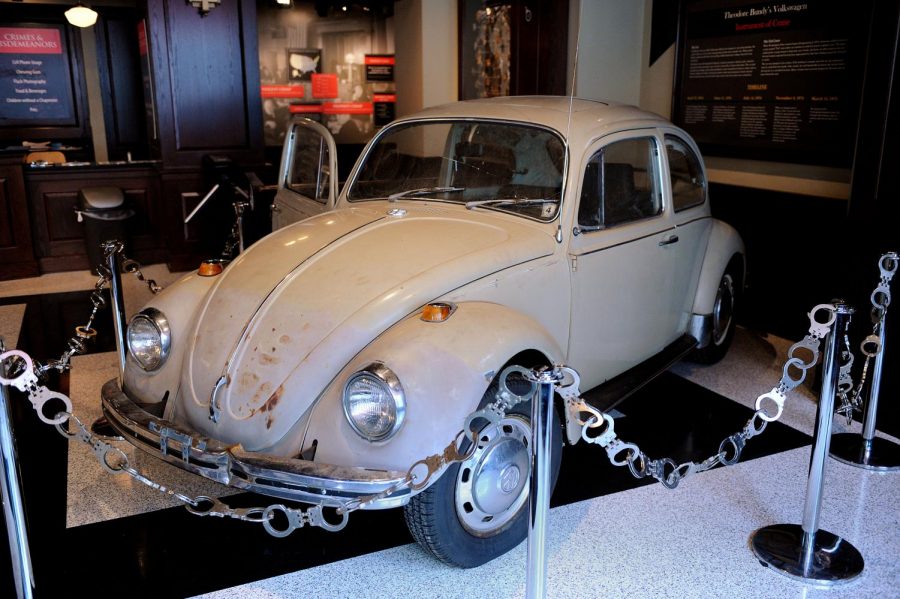Review: New Netflix docuseries captures horror of Ted Bundy
The new series “Conversations with a Killer: The Ted Bundy Tapes” explores the gruesome murders that shook America in the 1970s.
It may not be the Lincoln Memorial or the Smithsonian, but the 1968 Volkswagen Beetle driven by Ted Bundy, one of the most prolific serial murderers in history, is now a tourist attraction at the National Museum of Crime and Punishment in the nationÍs capitol, February 22, 2010. Bundy drove the car as he preyed on mostly young women in Washington state, Oregon, Utah and Colorado in the early 1970s. (Olivier Douliery/Abaca Press/MCT)
February 1, 2019
Netflix streamers can now get an in-depth look into the life and crimes of one of the most infamous serial killers of all time, Ted Bundy, with the release of the new docuseries “Conversations with a Killer: The Ted Bundy Tapes.”
The show covers Bundy’s life, the killings, his numerous arrests, his escapes from custody, and finally his sentencing and execution. The events are a suspenseful journey for those who are less than knowledgeable about Bundy and his disturbing crimes. While the series overall is in-depth and engaging, it stumbles in the beginning in establishing general knowledge about the serial killer.
The main issue with this show is the rocky start during the first chapter. That installment is a muddied mess, with three timelines all being thrown at the viewers within the first 20 minutes. It touches on three points of Bundy’s life that will confuse most who aren’t already aware of the serial killer’s tale.
This 53-minute episode covers a lot of ground in its less than an hour running time. It focuses on Bundy at too many different stages of his life in a nonlinear format that can almost seem a little nonsensical, because the series as a whole tries to follow a linear format.
The show does pick back up by the second episode, and soon the three best aspects come into play, the first being the interview tapes. A key piece of the miniseries is how the creators weave footage of Bundy and news coverage of the murders with interview tapes recorded when he was on death row. These audio recordings play throughout the series and show Bundy in his full sociopathic maniac form.
The tapes demonstrate how Bundy was proud of his crimes and relished in the attention they gave him. It shows Bundy as the arrogant, charismatic, humoristic, heartless, serial-killing person he really was. The most unnerving parts of these tapes occur once he is talked into explaining his motives for the crimes; the tapes are used to help contrast other interviews Bundy did and help to show Bundy’s delusional view of reality.
The interviews in this series include a mix of law enforcement, lawyers, friends, family, and a surviving victim of Bundy, with the most striking interviews being one with a childhood friend of his.
The interview, in which Bundy’s friend explains how dark and twisted he actually acted toward the children they grew up with, played parallel while Bundy reminiscing about his “picture perfect” childhood.
This is a common thread throughout the documentary, showing how Bundy was a master deceiver and often lied about his life to appear more “normal” than he was.
The second striking interview with from a Florida officer who investigated a case in which Bundy killed a 12-year-old girl. His reaction in the documentary is something many won’t forget. The officer’s response to watching Bundy be executed is also something that is both chilling and remorseful.
The old footage, too, helps set the tone for the series. The imagery and video place the viewer in the ’70s, with almost schizophrenic cuts that paint a dark look into a world in which the killer is loose. Younger viewers will find much of the footage fascinating because it’s almost four decades old.
The series helps tell a horrific stranger-than-fiction story that many will be drawn to; it might take getting past the first episode to really draw viewers in. The documentary will definitely entertain those who enjoy exploring the true crimes that captivated a nation and struck fear in the hearts of Americans 40 years ago.




